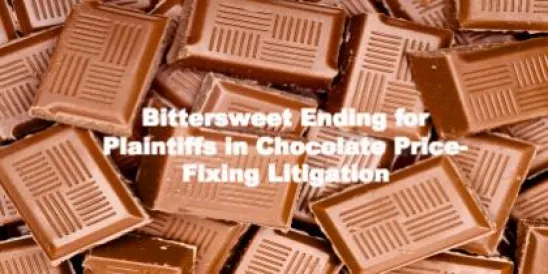In a February 26, 2014 Memorandum, Chief Judge Christopher C. Conner of the United States District Court for the Middle District of Pennsylvania granted summary judgment for three defendants Mars, Inc., Nestlé USA, Inc., and The Hershey Company in a detailed opinion. The plaintiffs filed suit against chocolate manufacturers nearly six years ago, claiming that they conspired to fix the prices of various chocolate products. The decision is helpful for defendants as precedent that even lock-step price increases are not enough to survive summary judgment in a price-fixing case, at least in a market with few competitors. Judge Conner’s decision also demonstrates for defendants the value of developing and shepherding a comprehensive record to support the argument that their decisions were independent and economically and rationally defensible.
The plaintiffs relied on circumstantial evidence and an inference that parallel price increases were the result of a tacit agreement to engage in collusive behavior, “actuated” by a conspiracy in Canada that resulted in at least one guilty plea by a Canadian chocolate manufacturer. Judge Conner relied in part on a finding that the Canadian conspiracy made a similar conspiracy in the United States more plausible in denying the defendants’ motion to dismiss the complaint. In re Chocolate Confectionary Antitrust Litig., 602 F. Supp. 2d 538 (M.D. Pa. 2009).
Judge Conner found at the summary judgment stage, however, that there was no evidence that executives responsible for pricing in the United States were aware of any anticompetitive activity in Canada, and concluded that the rest of the plaintiffs’ evidence was insufficient to preclude summary judgment for the defendants. The plaintiffs had no direct evidence of conspiracy, so they were required to show both that the defendants consciously raised prices in parallel as well as sufficient evidence of “plus factors.” In this case, the court considered three plus factors: (1) the defendants’ motive and market factors; (2) whether the defendants’ behavior was against their self-interest; and (3) traditional conspiracy evidence. The plaintiffs’ evidence of parallel pricing was the strongest part of their case. The court concluded that Mars, Nestle, and Hershey raised prices in parallel because¾three times over the course of five years¾Mars initiated a price increase, and both Hershey and Nestle followed in quick succession (within one to two weeks) with nearly identical price increases (varying only once, and even then only by two-tenths of a penny).
The court recognized, however, that parallel price increases were not sufficient, especially in a market controlled by a few competitors (or an oligopoly) to support an inference of antitrust liability. The court concluded that the plaintiffs failed to demonstrate that the defendants acted against their own self-interest as required by the second plus factor. In reaching this conclusion, the court first pointed to evidence that the defendants increased prices in anticipation of cost increases, stating “it is rational, competitive, and self-interest motivated behavior to increase prices for the purpose of mitigating the effect of anticipated cost increases.” Judge Conner also cited to what he described as “extensive” internal communications before each increase in which each defendant unilaterally discussed whether they could raise prices as evidence of “independent and fiercely competitive business conduct,” not collusion. Finally, the court agreed with Nestle’s argument that widely supported economic principles supported its decision as the defendant with the smallest market share to follow the price increases of its competitors. In doing so, the court likely rejected an argument¾often made by plaintiffs¾that it was in Nestle’s best interest to cut prices and gain market share.
The court also concluded that the plaintiffs’ traditional evidence of conspiracy was insufficient to satisfy the third plus factor. The plaintiffs relied on three pieces of evidence to satisfy this factor: (1) the Canadian conspiracy; (2) the defendants’ possession of competitors’ pricing information; and (3) the defendants’ opportunity to conspire at trade association meetings. While the court accepted that the Canadian conspiracy could, in theory, facilitate a conspiracy in the United States, it found the facts did not support the application of the theory in this case because there was no evidence that U.S. decision-makers had knowledge of the Canadian conspiracy and there was no tie between the pricing activities in the two countries. From the court’s opinion, it appears the plaintiffs had little traditional conspiracy evidence beyond the supposed connection to Canada. The court rejected an argument that a “handful” of documents suggesting that the defendants were aware of competitors’ price increases before they were made public supported an inference of conspiracy. There was no evidence that the pricing information came from competitors, and the court concluded that this exchange of advance price information was as consistent with independent competitive behavior as it was with collusion. Finally, the court ruled that the presence of company officers at trade meetings¾without any evidence that they discussed prices there¾was insufficient to permit an inference that the price increases were the result of collusive behavior. Reviewing the record as a whole, the court concluded that the plaintiffs had produced no evidence tending to exclude the possibility that the defendants acted independently.
Judge Conner’s opinion is a relatively straightforward application of the standard for ruling on summary judgment in antitrust cases set forth in the Supreme Court’s Matsushita decision and for parallel pricing cases as set forth in the Third Circuit’s Baby Foodand Flat Glass opinions. If appealed, Chocolate Confectionary is unlikely to result in a decision changing these standards significantly.
On the bright side for the plaintiffs, they reached a settlement with at least one defendant, Cadbury, before the summary judgment motion was ruled upon, so they will not be left empty handed.




 />i
/>i

